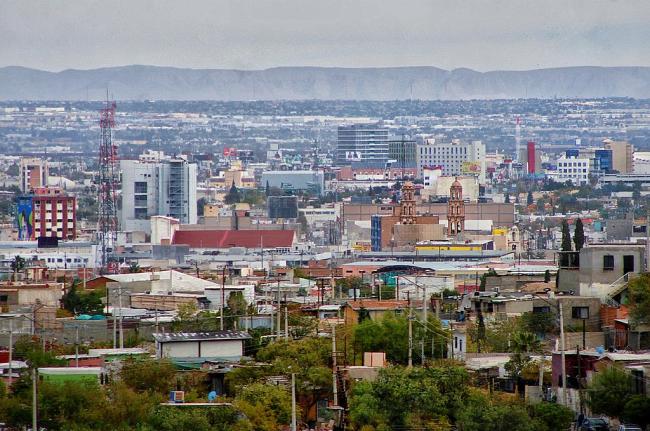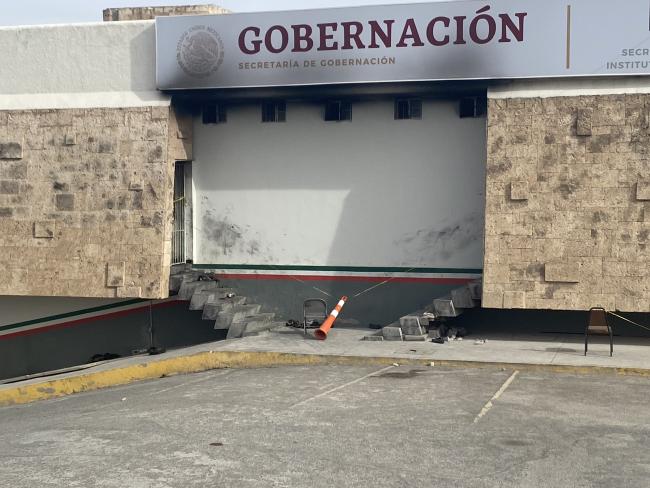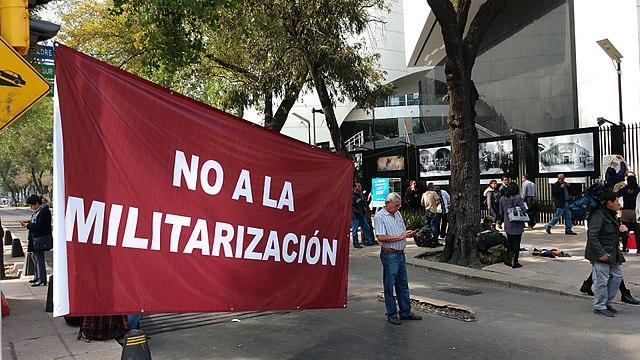
We write with profound sorrow and justified outrage. Forty people died in a fire at the Estación Lerdo shelter of the National Migration Institute of Mexico (INM) in Ciudad Juárez on the evening of March 27. Another 28 were injured, many seriously. The incident was foreseeable. The current U.S. policy thrust uses Mexico as a trap to prevent people from crossing northward, enclosing people in Mexico—especially its northern border cities—at great risk. Mexican policies and practices then exacerbate the murderous conditions that people experience in this situation of limbo and entrapment.
Because asylum traditionally applies to people physically in the United States, an asylum claim often begins when individuals are apprehended on the U.S. side of the border. That process is now being pushed into Mexico under inadequate systems of management and enforcement. The overcrowding in detention centers like Estación Lerdo was the direct result of orders to arrest migrants in downtown Ciudad Juárez, many of whom had legal status in Mexico. But multiple orchestrated policies from both countries placed these men in a Mexican government migration building with locked doors, where they were trapped in a terrible fire.
The United States is complicit in these deaths and current policy problematically incorporates Mexico as a key component of border enforcement. Our analysis draws on current research coauthor Jeremy Slack is conducting with asylum seekers in Ciudad Juárez.
The United States’ Asylum Ban
Currently, United States border policy involves near-immediate expulsions with no due process and no asylum options for many unauthorized border crossers. This occurs under Title 42, a U.S. public health law provision restricting the entry of non-citizens if they pose a “serious danger” of introducing a communicable disease. Under Title 42, migrants are either expelled to their home country or Mexico. The expulsion of non-Mexicans to Mexico, by agreement between the two countries, includes individuals from Guatemala, Honduras, El Salvador, Venezuela, Cuba, and Haiti. Migrants from the first four countries compose the bulk of the dead and injured in the fire.
While it is possible that the fire victims were all expelled under Title 42, some may have been waiting to attempt entry through the heavily guarded border. Regardless, without Title 42, those individuals would likely not have been in Mexico for the extended period that led to their apprehension in the streets of Juárez and detention in the “shelter.”
Title 42 is set to expire on May 11, the date set by the Biden administration to end the Covid-19 public health emergency, although lawsuits are underway attempting to keep it in place. Many other people are expelled at the border under immigration law provision Title 8, which enables limited due-process and the “expedited removal” of unauthorized entrants. A claim of asylum to the standard of credible fear, or in some cases reasonable fear, can halt the Title 8 expulsion, but U.S. pattern and practice at the border involves inconsistent application of asylum law. Furthermore, not all people have a basis for asylum, and may be rapidly expelled to Mexico.
For a limited portion of asylum seekers waiting in northern Mexico, a flawed alternative is to seek an appointment with U.S. authorities on a smart phone application called CBP One. If successful, applicants will have an asylum screening appointment directly at a U.S. port of entry. This app replaced advocacy organization staff who screened people waiting in Mexican northern border cities, identifying people with safety and health risks to be screened for asylum.

Our research and other evidence shows that the app has worked poorly, with constant glitches and insufficient appointment slots. High quality data service and adequate phones are hard to come by, and due to the high demand, any data or software failure can deny access to an appointment for the day. Users report that the portal often halts a few minutes after launching it in the morning. Facial recognition of darker skinned people is hampered by racial bias in the software, preventing some applicants from obtaining an appointment. The application was not designed to make joint appointments for family members, requiring multiple appointments even for young children who must apply alone (some agents will turn people away when this happens, while others allow them to apply). Due to security fears related to China, Huawei phones are incompatible with CBP One even though these phones are more affordable and frequently used by asylum seekers. Even when people complete their application in the allotted two minutes, the appointment is invalid without a confirmation email. Applicants have described trying to arrive for their appointments with screen shots only to be turned away by U.S. officials. The health and security risk criteria for asylum seekers is narrow and does not include important factors, such as LGBTQIA+ status. Furthermore, as the Ciudad Juárez fire shows, being an outsider under these strained circumstance poses increased risks. Non-Mexicans are often discriminated against in Mexico, and people lacking local social connections are readily victimized in northern border cities.
The United States’ bureaucratic response to these problems has been slow at best and malicious at worst. There is little recourse for asylum seekers to file complaints about the application. Resolving the issues with the app—providing adequate appointment slots, technical functionality, and clear expectations—could reduce risks for asylum seekers. An appointment at the port of entry is far superior to the expensive and dangerous crossing now needed for people to flag down authorities and begin an asylum claim. Even with substantial wait times, a reliable date would allow asylum seekers to find a safer and more comfortable place to await their appointments. As it stands, potential applicants have to be physically present in border cities, tracked by geolocation, and obligated to live in shelters, abandoned buildings, or encampments where they experience insecurity and exposure to the elements. This has escalated tensions between residents of Ciudad Juárez and asylum seekers, particularly Venezuelans who can be seen begging in the street throughout the downtown area. In response, state and local authorities have escalated anti-immigrant operations throughout the city.
The U.S. government has opened another route to temporary refuge in the United States: two-year humanitarian parole, which should reduce the need for people to cross Mexico and converge on the border. Parole is generally applied for in one’s country of origin and involves flying to the United States. However, it has serious limitations and applies only to applicants from Venezuela, Cuba, Nicaragua, and Haiti. Of these, only Venezuelans appear on the list of victims in Ciudad Juárez. The other main nationalities—Guatemala, Honduras, and El Salvador—are not eligible, even though compelling cases for asylum can be made for individuals coming from each of these countries (and Mexico). Humanitarian parole also requires a sponsor with economic resources in the United States, an airplane ticket, and a passport, which many potential asylum seekers do not have. These factors favor wealthier and more privileged applicants. Furthermore, people who irregularly crossed either the Panamanian or Mexican borders are not eligible for humanitarian parole, meaning this provision does not address the many people trapped in Mexico.
Looming on the horizon, the Biden administration has proposed a draconian reduction to the legal right to claim asylum, which would largely revive measures proposed during the Trump years that were blocked in the courts. These include the need to apply for asylum in third countries and restrictions on applying for asylum between ports of entry. For many migrants, immediate expulsion under these distortions of asylum policy will replace Title 42 if and when it ends. A continuation of these policies will undoubtedly lead to future tragedies akin to the Estación Lerdo fire as many thousands of people remain trapped in Mexico.
Mexico as Immigration Enforcer

Mexico’s role in this tragedy goes beyond accepting U.S. policies that send asylum seekers back to Mexico. Mexico’s increase in immigration and border policing centers largely on the formation of the National Guard (GN). In 2019, as Trump threatened to cut off trade from Mexico, President Andres Manuel López Obrador dissolved the federal police and incorporated its members and sectors of the armed forces into the GN, whose principal mission has been to impede asylum seekers from crossing through Mexico. The GN collaborates closely with the Nacional Migration Institute (INM) but has been plagued with scandals. Some 8,565 complaints have been filed about criminal behavior by the GN between 2019 and 2022, but only 1,135 investigations carried out during this period. Complaints include ties to criminal organizations, extortion, kidnapping, and even murder. On the northern border, asylum seekers indicate that the GN has worked closely with criminal organizations to control human smuggling, often stopping people to collect bribes and demanding they cross with “approved” smugglers.
With tensions rising, the police, GN, and INM agents began arresting people for vagrancy or immigration violations in the weeks leading up to the fire. Generally, asylum seekers thought of authorities at the border as fairly benign, unlikely to send people back to their home country. In a February interview conducted in Ciudad Juárez, an asylum seeker from Venezuela said “If they catch you before Mexico City, they send you to Guatemala. If they catch you in Chihuahua [city] they send you to Mexico City, but up here they don’t bother you.”
However, this has begun to change as people are increasingly swept up, detained, and threatened with deportation if they cannot pay a bribe. While local sentiment has been heavily focused on Venezuelans, the largely Indigenous and poorer asylum seekers from Guatemala have born the brunt of enforcement, likely because they have less money for bribes. Title 42 and other restrictive U.S. policies have largely targeted asylum seekers from Mexico, Guatemala, Honduras, and El Salvador. The last three nationalities made up three-quarters of those killed and injured in the fire.
Mexico has frequently changed course on the passage of migrants and asylum seekers through their territory, at times cracking down, forcing people on top of trains, and in other moments allowing people to take buses and travel safely through the country. With the recent increase in arrests, there have been considerable concerns about detention conditions in Mexico. The country has little oversight over security forces and is unprepared to detain foreign nationals in INM facilities. A recent report by researchers at the Universidad Iberoamericano de Puebla has shown abuses, lack of due process, minors detained without adults, suicide attempts, and lack of access to healthcare. Mexico’s rapid militarization of immigration enforcement means that migrants will continue to suffer in inhumane conditions with limited oversight and accountability.
Lessons to be Learned
The lack of direction, sudden policy changes, and inhumane conditions faced by migrants in violent border cities make the tragedy at Estación Lerdo foreseeable and preventable. It is imperative that both the United States and Mexico engage in good faith efforts to uphold the law and provide a clear process for asylum-seekers. Restrictive and chaotic border policies have led to many deaths, far beyond the 40 who died in the fire. Of the record 853 deaths reported on the border in 2022, many would not have taken those risks if allowed to apply for asylum at a legal port of entry. The true cost of these policies must also consider those individuals that were turned back and killed in their home countries, and those kidnapped and killed along the border that aren’t included in official figures. Attention has focused on the inexcusable INM orders to maintain the building locked while the fire burned, but a deeper understanding of the causes of this tragedy implicates the increasingly joined repressive immigration policies of both the United States and Mexico.
Editor's note: The title of this article has been amended from "shelter fire" to "migrant detention center" to more accurately describe the location of the fire. The language of "shelter" has been used by the Mexican government to deflect attention away from the causes of the fire. Corrected on April 21, 2023.
Josiah Heyman is Professor of Anthropology and Director of the Center for Inter-American and Border Studies at the University of Texas at El Paso.
Jeremy Slack is Associate Professor of Geography in the Department of Sociology and Anthropology at the University of Texas at El Paso.

